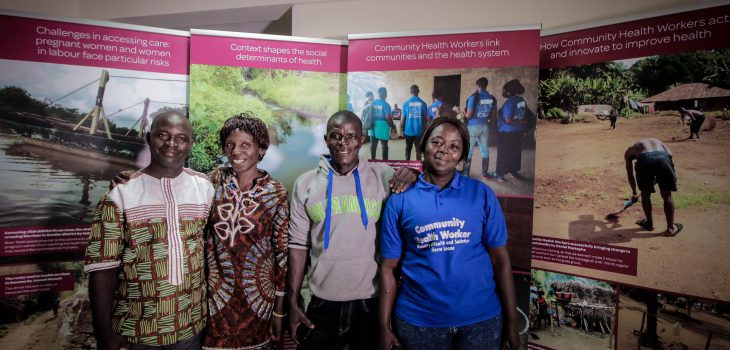By Teralynn Ludwick, Sumit Kane, Barbara McPake and Alison Morgan (Nossal Institute for Global Health, University of Melbourne, Australia)
In this blog series we are giving a voice to practitioners, implementers and policy-makers involved in national COVID-19 responses in low- and middle-income countries. These posts seek to facilitate timely cross- learning by sharing opinions, insights and lessons on the challenges and actions taken by those on the COVID-19 front line.
What roles should urban community health workers be performing in the context of COVID-19?
As the number of COVID-19 cases in low- and middle-income countries (LMICs) continues to grow, the global health community is debating what roles community health workers (CHWs) could and should play in the prevention, detection, and management of COVID-19 cases. Yet to be discussed within this debate is how urban versus rural settings present different opportunities and risks for CHWs, and how should these factors inform the roles they take on?
Currently, what limited evidence we have on CHW roles in pandemics draws heavily from rural responses, particularly the 2014 Ebola outbreaks. In this commentary, we use our recently published framework and scoping review on the distinctive roles performed by urban CHWs in LMICs to frame a discussion around opportunities and ethical issues of assigning COVID 19-related tasks to urban CHWs.
A quick categorization of the range of pandemic-related roles being proposed in recent publications shows that they generally fit within the typical CHW scope of work that we identified in our review:
| Typical roles performed by urban CHWs | Potential pandemic-related tasks for urban CHWs |
| Providing health education and skills for behavioural change | ● Trusted communicator: give culturally appropriate information on sanitation, hand hygiene, physical distancing etc; provide information about vaccines once developed
● Convey techniques for minimizing spread where self-isolation is challenging ● Dispel misconceptions and counter social stigma |
| Performing outreach and linking members to services | ● Assist with triage/referrals: assess needs of vulnerable individuals for more advanced care
● Monitor/refer patients who are self-isolating |
| Providing direct services and treatment | ● Treatment: support patients with mild symptoms
● Screening: use standardized screening questions to detect potential cases ● Distribute commodities: e.g. soap, buckets, hand sanitizer, gloves; provide food deliveries to those self-isolating; deliver test kits and samples ● Support contact tracing teams |
| Supporting health administrative and information systems | ● Identify/report cluster outbreaks through community-based surveillance systems
● Symptom reporting |
| Providing psychosocial support and counselling | ● Provide social support to affected households |
| Acting as mediators between clients, communities and health services | ● No clearly identified tasks |
| Empowering communities to take social action that addresses the social determinants of health | ● No clearly identified tasks |
Given the fit of these new tasks within the scope of existing roles and the available evidence on urban CHW effectiveness in carrying out similar tasks (but for different health issues), the extension of urban CHW roles to include pandemic response tasks seems feasible. The question is whether these roles will produce significant population health benefits that outweigh the risks posed to CHWs.
Let’s consider some features of the urban setting that have a bearing on the relevance and safety of these tasks. On the one hand, the greater availability of tertiary care services in cities makes it more feasible for CHWs to refer patients with acute COVID-19 symptoms. On the other hand, urban dwellers, even disadvantaged individuals, may not rely on CHWs as trusted gateways to formal care in the same way that rural residents do. Affected individuals are likely to bypass community-based services and access hospitals directly. Further, information about COVID-19 is widespread in the media, which may decrease the need for CHWs to carryout household-level dissemination.
A potentially more unique and useful role could be CHW assistance in helping contact tracing teams navigate neighborhoods – both geographically (where addresses are poorly documented) and in terms of access (where receptivity to outside officials is poor). The concentration of health professionals in cities also provides an opportunity for interprofessional teams to include CHWs. With supervision from nurses, Liberia is preparing CHWs to assist with case detection and South Africa is involving CHWs in mass screening and testing through the COVID Home Visits program. Given that supply chains and supportive supervision are typically disrupted during crises, teamwork approaches could help offset some of these risks by providing more support and better access to personal protective equipment – theoretically. Nevertheless, all community-based work presents significant risk of COVID-19 exposure, stigmatization, and violence – as has been seen elsewhere.
Globally, most sectors are being asked to limit their business to essential services. Perhaps this principle should guide what we ask of urban CHWs. Maintaining essential services might include continued CHW support to individuals with pre-existing conditions (e.g. tuberculosis, HIV/AIDS) and support for maintaining routine immunizations. Exploring options for safe, essential service provision, including monitoring and follow-up by mobile phone, could also have ongoing utility for urban CHW roles post COVID-19.
In thinking about what CHWs can and should do during emergencies, we must balance society’s needs with what is reasonable to ask of a cadre which is always lowly-paid, and often comprised of volunteers. Notably, the very people we are asking to step into risky roles are rarely asked to be part of decision-making around these roles. This should perhaps be the starting point for discussing what roles they should perform.
Related paper:
Image credit: The main image is a photograph of Community Health Workers in Sierra Leone who participated in the ReBUILD programme [Link]











